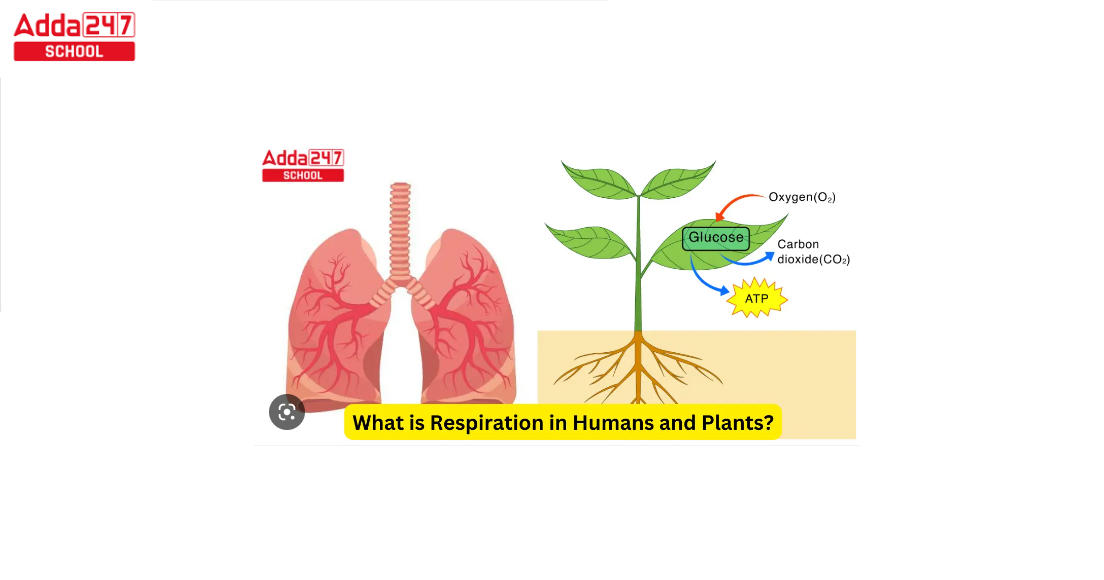Table of Contents
What is Respiration: Respiration is an essential aspect of life that enables organisms to transform energy from nutrients into a form that can be utilized by the body. This intricate process involves the exchange of gases between an organism and its surroundings with the end result being the production of ATP.
In this article, we will tell you about What Is Respiration? The different types and stages of respiration and how the survival is dependent upon respiration, whether it be for the simplest organisms or the most complex mammals.
What Is Respiration in Plants and Humans?
The exchange of gasses between an organism’s body cells and the outside environment is known as respiration. All living things, including plants, animals, prokaryotic bacteria, eukaryotic protists, fungi, and humans, engage in respiration.
During typical human respiration, glucose and oxygen react to create the energy required for movement, growth, and repair. The bi-products of respiration, water and carbon dioxide, must be eliminated.
The respiratory process is an essential metabolic activity shared by all living beings. It involves a complex biochemical reaction that occurs intracellularly within organisms.
As a result of the chemical reaction whereby glucose is broken down, cells are able to harness energy (ATP-Adenosine triphosphate) that’s subsequently utilized in executing an array of functions. All living things, from basic single-celled organisms to dominant multicellular ones, have the ability to breathe.
What Is Respiration in Biology?- Types of Respiration
There are two types of respiration:
1. Aerobic Respiration:
Aerobic Respiration In Animals- It is a type of cellular respiration that uses oxygen to produce energy. Within the cells of both plants and animals, it is an ongoing process. The chemical equation can be used to explain this procedure:
Glucose(C6H12O6) + Oxygen(6O2)= Carbon dioxide(6CO2) + Water(6H2O)+ Energy (ATP)
During this type of respiration, glucose molecules split in the presence of oxygen, releasing the end products of (CO2), water, and energy in the form of ATP. This reaction releases 2900 KJ of total energy, which is converted into ATP molecules. All varieties of multicellular organisms exhibit it.
Aerobic Respiration In Plants- When oxygen, or O2, enters plant cells through the stomata located in the epidermis of leaves, aerobic respiration in plants begins. Then, photosynthesis is carried out, which gives off energy and produces food for the plant’s body. The resulting chemical reaction is as follows:
Carbon dioxide 6(CO2) + Water 6(H2O) → Glucose (C6H12O6) + Oxygen 6(O2)
2. Anaerobic Respiration
It is a type of energy-producing cellular respiration that takes place in the absence of oxygen. Anaerobic respiration’s chemical formula is
Glucose(C6H12O6)= Alcohol 2(C2H5OH) + Carbon dioxide 2(CO2) + Energy (ATP )
Lactic acid fermentation
Anaerobic lactic acid fermentation involves breaking down glucose to create two molecules of lactic acid and a pair of ATP molecules, but with no presence of oxygen.
Alcoholic fermentation
Anaerobic respiration takes the form of alcoholic fermentation when glucose is broken down in the absence of oxygen to form two molecules each of ethanol, carbon dioxide, and ATP. The chemical breakdown goes as follows:
Glucose C6H12O6 → Alcohol 2(C2H5OH) + Carbon dioxide 2(CO2) + Energy (ATP )
What Is Respiration in Plants and Humans?- Methods Of Respiration for Class 10
-
External Respiration
One way to get oxygen from the environment is through breathing or external respiration. Animal organisms perform the process of external respiration in a variety of ways.
While other animals either have organs that are specifically designed for gas exchange or have a full respiratory system, those without specialized organs for respiration must obtain oxygen by diffusing it across the surfaces of external tissue.
Gasses and nutrients are exchanged with the outside environment by diffusion across the surface of organisms like nematodes. Tracheae, the respiratory organs found in insects, spiders, and fish, serve as sites for gas exchange.
-
Internal Respiration
This is the secondary process that takes place within the organism’s body. Gasses are transported between the blood and body tissues during internal respiration.
The thin epithelium of the lung alveoli, or air sacs, allows oxygen from the lungs to diffuse into nearby capillaries containing oxygen-depleted blood.
At the same time, carbon dioxide diffuses and escapes from the lung alveoli in the opposite direction (from the blood). The circulatory system carries oxygen-rich blood from lung capillaries to the body’s cells and tissues.
-
Cellular Respiration
Cells use oxygen through cellular respiration. Foods contain a collection of complex biomolecules such as carbohydrates and proteins that necessitate conversion into an accessible form for the body to extract their inherent energy.
This is done during digestion when nutrients are absorbed into the blood and food is broken down. Nutrition is delivered to body cells by blood circulation throughout the body.
C6H12O6 (glucose) + 2 ADP + 2 Phosphate= 2 LACTIC ACID + 2 ATP
Body muscles produce ATP during exercise more quickly than they are able to be supplied with it. When this happens, phenomenon takes place, there will be a surplus of glycolysis in the cells of muscles which surpasses what can naturally enter into the intricate system responsible for transporting energy. This is why, following a lengthy workout, lactic acid fermentation occurs in our cells and causes our muscles to ache.
What Is Respiration Stages in an Organism’s Respiration Process
Respiration takes place near the plasma membrane and in its cytosol within prokaryotic cells. However, eukaryotic cells confine this same oxidative process uniquely to their mitochondria – organelles that are informally known as “powerhouses” due to their unparalleled energy production abilities.
The internal combustion of a car engine, the removal of organic compounds and oxygen, and the removal of water and carbon dioxide, similar to this process. It gets power from the car (or battery) power outlet. The three stages of respiration are as follows:
-
Glycolysis
In this stage glucose molecules are converted into pyruvic acid, after which it is further broken down into carbon dioxide and water, leaving 2 carbon molecules known as acetyl-CoA behind.
In the process of glycolysis, 2 molecules of ATP and 2 molecules of NADH are produced. The Kreb’s cycle involves the oxidation of pyruvate as it enters the inner matrix of mitochondria.
-
Oxidative Phosphorylation
In the process of oxidative phosphorylation, ATP molecules are created as a result of a series of electron carriers moving electrons from NADH or FADH2 to O2. Within a cell’s mitochondria, this process happens.
-
Citric Acid Cycle
The Kreb’s cycle or the tricarboxylic acid cycle are other names for this. The citric acid cycle occurs inside the mitochondrial matrix of a cell, and each phase generates two ATP molecules. The mitochondrial matrix is traversed by the electrons produced in Kreb’s cycle.


 JEE Mains Session 2 Result 2024 Out, Get...
JEE Mains Session 2 Result 2024 Out, Get...
 MHT CET Previous Year Papers, Download M...
MHT CET Previous Year Papers, Download M...
 Madhyamik Result 2024 Date, WB Madhyamik...
Madhyamik Result 2024 Date, WB Madhyamik...














